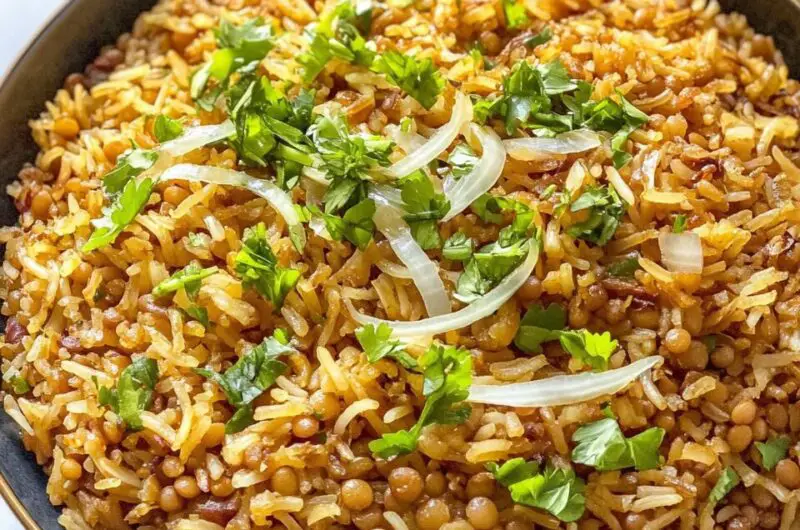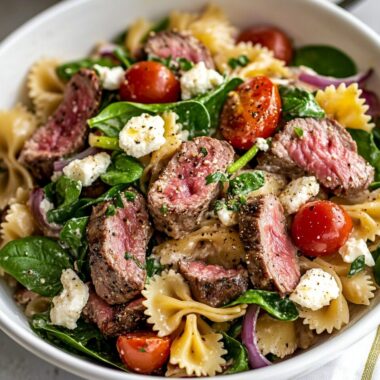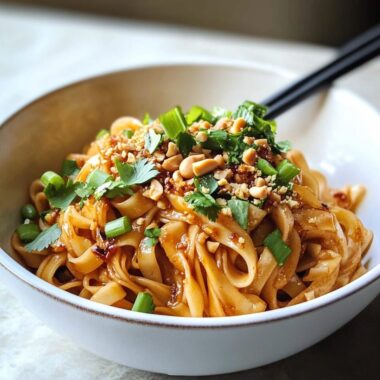The hearty simplicity of Mujaddara makes it a standout in plant-based cuisine. With caramelized onions lending deep sweetness and lentils providing earthy richness, this dish is comforting, nutritious, and beautifully balanced. It’s an iconic Middle Eastern meal that’s easy to prepare and incredibly satisfying. Whether served as a main dish or a hearty side, Mujaddara is a versatile recipe that proves minimal ingredients can yield maximum flavor. Perfect for weeknight dinners, meal prep, or gatherings, this dish shines with wholesome ingredients and warm, spiced undertones that make it a family favorite.
Full Recipe:
Ingredients:
-
1 cup brown or green lentils
-
¾ cup basmati or long-grain rice
-
3 large yellow onions, thinly sliced
-
¼ cup extra virgin olive oil
-
½ teaspoon ground cumin
-
½ teaspoon ground coriander
-
½ teaspoon cinnamon
-
Salt and pepper to taste
-
4 cups water
-
Fresh parsley or mint for garnish (optional)
Directions:
-
Rinse the lentils thoroughly and place them in a pot with 2 cups of water. Bring to a boil, then reduce heat and simmer for 15 minutes. Drain and set aside.
-
In a large skillet, heat olive oil over medium heat. Add sliced onions and a pinch of salt. Sauté for 30–40 minutes, stirring occasionally, until the onions are deeply caramelized and golden brown. Remove half of the onions and set aside for garnish.
-
Add the rinsed rice, partially cooked lentils, cumin, coriander, cinnamon, salt, and pepper to the skillet with the remaining onions. Stir everything together.
-
Pour in 2 cups of water, bring to a boil, then reduce heat to low. Cover and simmer for 20 minutes, or until the rice and lentils are tender and water is absorbed.
-
Turn off the heat and let the dish rest, covered, for 5–10 minutes.
-
Fluff with a fork, garnish with the reserved caramelized onions and chopped parsley or mint before serving.
Prep Time: 10 minutes | Cooking Time: 55 minutes | Total Time: 1 hour 5 minutes
Kcal: 390 kcal | Servings: 4 servings
Discover the Magic of Mujaddara: A Timeless Middle Eastern Comfort Dish
Mujaddara is a beloved dish with ancient roots, widely consumed throughout the Middle East, including countries like Lebanon, Syria, Jordan, Palestine, and Egypt. At its heart, it’s a humble blend of lentils and rice topped with deeply caramelized onions simple ingredients that, when combined, create a dish rich in flavor and cultural significance. Often described as the “working-class meal” due to its affordability and accessibility, Mujaddara has long been a staple in both rural and urban households.
This dish is not just about sustenance; it’s a celebration of flavor, texture, and tradition. In Arabic, Mujaddara means “pockmarked,” referring to the way lentils appear speckled through the rice. The dish is so loved that it exists in multiple variations, including versions made with bulgur (known as Mujaddara Hamra), making it highly adaptable based on regional preferences and ingredient availability.
A Cultural and Historical Staple
Historically, Mujaddara has been served both as an everyday meal and as part of larger gatherings. It appears in medieval Arab cookbooks and has stood the test of time as a comfort food for generations. It’s a dish that tells a story of family, of resilience, and of a connection to the land. In many Middle Eastern homes, it’s still considered a go-to dish during Lent, Ramadan, or periods of fasting, particularly in Christian and Muslim communities.
Despite its humble ingredients, Mujaddara is often served with reverence. In some traditions, it’s served as a Friday meal or offered to guests as a symbol of hospitality. It also plays a role in holiday feasts and religious observances, where plant-based meals are favored.
Why Mujaddara Deserves a Spot in Your Recipe Collection
There are countless reasons to include Mujaddara in your regular meal rotation:
1. Plant-Based & Naturally Gluten-Free
Mujaddara is naturally vegan and gluten-free, making it an excellent option for people with dietary restrictions. There are no animal products, processed ingredients, or hidden allergens just wholesome lentils, rice, onions, and spices.
2. High in Nutrients
Lentils are a plant-based protein powerhouse. Packed with fiber, folate, iron, and other essential nutrients, they provide long-lasting energy and are beneficial for heart health. Paired with rice, the combination forms a complete protein, supplying all nine essential amino acids.
Onions, though often overlooked nutritionally, are rich in antioxidants and beneficial plant compounds like quercetin, known for anti-inflammatory properties.
3. Economical & Accessible
The ingredients for Mujaddara are pantry staples in most kitchens. Brown or green lentils, rice (basmati or long-grain), onions, and olive oil are both affordable and readily available around the world. This makes the dish ideal for budget-conscious households and meal prepping.
4. Flavor-Packed Despite Simplicity
One of the most striking aspects of Mujaddara is how deeply flavorful it is with so few ingredients. The slow caramelization of onions transforms them into a sweet, golden topping that enhances the earthy lentils and fluffy rice underneath. A touch of spice typically cumin, coriander, or cinnamon adds warmth without overpowering the dish.
5. Flexible & Customizable
Mujaddara is easy to personalize. Some people add garlic, chili flakes, or bay leaves to the cooking water. Others garnish with fresh herbs like mint or parsley, a drizzle of olive oil, or a spoonful of vegan yogurt or tahini sauce. You can even swap the rice for bulgur or quinoa to change the texture and nutrient profile.
How Mujaddara is Enjoyed Around the World
In Lebanon
The Lebanese version of Mujaddara, called Mujaddara Makhbousa or Mujaddara Safra, is often made with a smoother consistency, almost like a porridge. It’s typically served warm with cucumber and tomato salad or plain yogurt.
In Palestine & Jordan
These versions are usually rice-based and include generous portions of caramelized onions on top. It’s common to see Mujaddara served with a fresh tomato-cucumber salad, pickles (mukhalal), or plain labneh.
In Egypt
Though not called Mujaddara, a similar lentil and rice dish is part of the Egyptian culinary scene, often incorporated into koshari, a more complex street food dish combining lentils, rice, macaroni, tomato sauce, and fried onions.
Pairing Suggestions and Serving Tips
Mujaddara is wonderfully versatile when it comes to what you can serve with it. Here are a few ideas:
-
Crisp Salads: A side salad of cucumber, tomato, red onion, and fresh herbs with a lemony vinaigrette cuts through the richness of the dish.
-
Yogurt-Based Sauces: Non-dairy yogurt with lemon and mint makes a perfect creamy contrast.
-
Pickled Vegetables: Quick-pickled red onions or turnips add a delightful crunch and tang.
-
Pita or Flatbread: Scoop Mujaddara with warm flatbread for a more hands-on dining experience.
-
Roasted Vegetables: Oven-roasted carrots, cauliflower, or sweet potatoes complement the flavor and add variety.
If you’re packing this dish for lunch or meal prep, Mujaddara travels well and tastes even better the next day after the flavors have melded.
Storing and Reheating
Mujaddara keeps well in the fridge for up to 4–5 days in an airtight container. It also freezes beautifully, making it a great make-ahead option. Reheat gently on the stovetop or in the microwave with a splash of water or olive oil to revive the moisture and fluffiness of the rice.
Common Mistakes to Avoid
-
Undercooking or overcooking the lentils: You want them tender but not mushy. Overcooked lentils will make the final dish overly soft.
-
Rushing the onions: Caramelization takes time. Skipping this step robs the dish of its signature depth of flavor.
-
Using too much water: The goal is fluffy, distinct grains of rice not risotto. Follow recommended water ratios to avoid a soggy final product.
Mujaddara in Modern Plant-Based Cuisine
As more people adopt vegetarian or vegan lifestyles, traditional dishes like Mujaddara are gaining popularity far beyond their cultural origins. It’s a great example of how “old-world” recipes can fit seamlessly into modern diets. Mujaddara proves that plant-based food can be nourishing, satisfying, and emotionally comforting without requiring exotic ingredients or complicated techniques.
Many food bloggers and chefs are now showcasing Mujaddara on their platforms, adding it to recipe books and meal plans. Its cross-cultural appeal makes it a universal dish simple enough for beginner cooks, yet sophisticated enough for experienced chefs to reimagine.
Conclusion:
Mujaddara is a dish that exemplifies how a few simple, wholesome ingredients can be transformed into something truly extraordinary. Its rich history, versatility, and nutritional value make it a cornerstone of Middle Eastern cuisine and a hidden gem in plant-based cooking.
Whether you’re looking to explore new cultural flavors, eat more mindfully, or simply prepare a budget-friendly and satisfying meal, Mujaddara checks every box. It’s comfort food at its finest warm, flavorful, and deeply nourishing. Add it to your weekly menu, and it might just become a permanent favorite.








